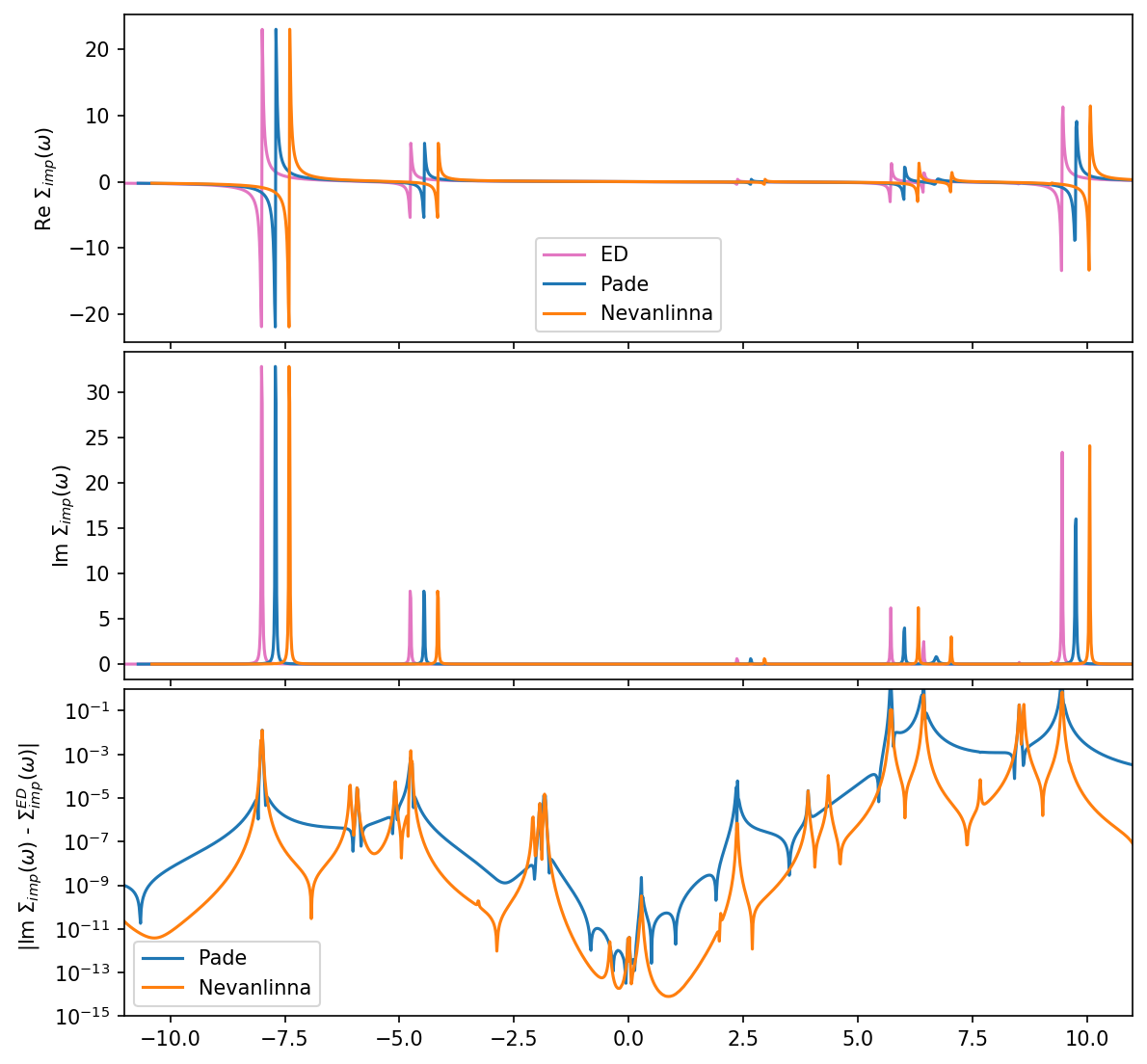Single impurity Anderson model with discrete bath
We calculate the Green function for a SIAM with a discrete bath
where
and
by solving it with exact diagonalization. Then we can construct an impurity Green’s function and self-energy via their spectral representation on both imaginary and real frequency axis. The imaginary axis result can be continued using Nevanlinna and compared to the real frequency result.
First we import necessary modules:
[20]:
import sys, os
import numpy as np
from triqs.plot.mpl_interface import plt,oplot
from h5 import HDFArchive
from triqs.atom_diag import *
from triqs.gf import *
from triqs.operators import c, c_dag, n, dagger
from itertools import product
# Get a list of all annihilation operators from a many-body operators
def get_fundamental_operators(op):
idx_lst = []
for term, val in op:
for has_dagger, (bl, orb) in term:
if not idx_lst.count([bl, orb]):
idx_lst.append([bl,orb])
return [c(bl, orb) for bl, orb in idx_lst]
SIAM system parameters
we define the SIAM as follows:
[2]:
beta = 40. # Inverse temperature
mu = 1. # Chemical potential
U = 2. # On-site density-density interaction
E = [ 0.0, 2.0 ] # Bath-site energies
V = [ 1.0, 2.5 ] # Couplings to Bath-sites
n_orb = 1
n_orb_bath = len(E)
# triqs block structure
block_names = ['up', 'dn']
gf_struct = [ (s, n_orb) for s in block_names ]
# block structure of full Hamiltonian
gf_struct_tot = [[s, n_orb + n_orb_bath] for s in block_names]
# Green's function parameters
n_iw = int(20 * beta)
iw_mesh = MeshImFreq(beta, 'Fermion', n_iw)
n_w = 1501
window = [-11,11]
w_mesh = MeshReFreq(window=window,n_w=n_w)
eta = 0.01
# ==== Local Hamiltonian ====
h_0 = - mu*( n('up',0) + n('dn',0) )
h_int = U * n('up',0) * n('dn',0)
h_imp = h_0 + h_int
# ==== Bath & Coupling Hamiltonian ====
h_bath, h_coup = 0, 0
for i, (E_i, V_i) in enumerate(zip(E, V)):
for sig in ['up','dn']:
h_bath += E_i * n(sig,n_orb + i)
h_coup += V_i * (c_dag(sig,0) * c(sig,n_orb + i) + c_dag(sig,n_orb + i) * c(sig,0))
# ==== Total impurity hamiltonian ====
h_tot = h_imp + h_coup + h_bath
Construct hybridization function and Weiss Field
[3]:
Delta_iw = BlockGf(mesh=iw_mesh, gf_struct=gf_struct)
Delta_iw << sum([V_i*V_i * inverse(iOmega_n - E_i) for V_i,E_i in zip(V, E)]);
# real frequency
Delta_w = BlockGf(mesh=w_mesh, gf_struct=gf_struct)
Delta_w << sum([V_i*V_i * inverse(Omega - E_i + 1j*eta) for V_i,E_i in zip(V, E)]);
# Weiss field
G0_iw = BlockGf(mesh=iw_mesh, gf_struct=gf_struct)
G0_iw['up'] << inverse(iOmega_n + mu - Delta_iw['up'])
G0_iw['dn'] << inverse(iOmega_n + mu- Delta_iw['dn'])
# real frequency
G0_w = BlockGf(mesh=w_mesh, gf_struct=gf_struct)
G0_w['up'] << inverse(Omega + mu - Delta_w['up'] + 1j*eta )
G0_w['dn'] << inverse(Omega + mu - Delta_w['dn'] + 1j*eta )
[3]:
Greens Function G_dn with mesh Real Freq Mesh with w_min = -11, w_max = 11, n_w = 1501 and target_shape (1, 1):
Construct the AtomDiag Object and solve it
[4]:
# define fundamental operators
fop_imp = [(s,o) for s, n in gf_struct for o in range(n)]
fop_bath = [(s,o) for s, o in product(block_names, range(n_orb, n_orb + n_orb_bath))]
fop_tot = fop_imp + fop_bath
# ED object
ad_tot = AtomDiag(h_tot, fop_tot)
Calculate and plot the single-particle Green function and self-energy
[5]:
G_iw_tot = atomic_g_iw(ad_tot, beta, gf_struct_tot, n_iw)
block_list = [G_iw_tot[bl][:n_orb, :n_orb] for bl, n_orb in gf_struct]
G_iw = BlockGf(name_list=block_names, block_list=block_list)
# real frequency
G_w_tot = atomic_g_w(ad_tot, beta, gf_struct_tot, window,n_w, eta)
block_list = [G_w_tot[bl][:n_orb, :n_orb] for bl, n_orb in gf_struct]
G_w = BlockGf(name_list=block_names, block_list=block_list)
fig, ax = plt.subplots(1,1, figsize=(6,3), dpi=150, squeeze=False)
ax = ax.reshape(-1)
ax[0].oplot(-G_w['up'][0,0].imag)
ax[0].set_ylabel(r'Im G$_{imp} (\omega)$')
ax[0].set_ylim(0,10)
ax[0].set_xlim(window)
ax[0].get_legend().remove()
plt.show()
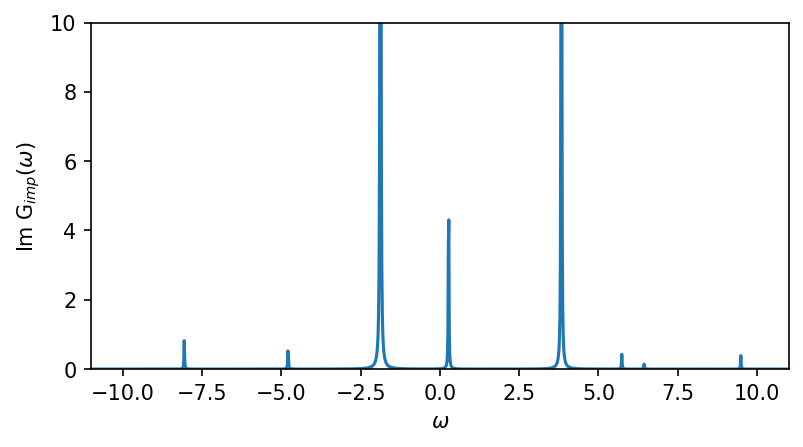
[6]:
S_iw = G0_iw.copy()
S_iw << inverse(G0_iw) - inverse(G_iw)
S_w = G0_w.copy()
S_w << inverse(G0_w) - inverse(G_w)
fig, ax = plt.subplots(1,1, figsize=(6,3), dpi=150, squeeze=False)
ax = ax.reshape(-1)
ax[0].oplot(-S_w['up'][0,0].imag, label='Im')
ax[0].oplot(-S_w['up'][0,0].real, label='Re')
ax[0].set_ylabel(r'$\Sigma_{imp} (\omega)$')
ax[0].set_ylim(-10,10)
ax[0].set_xlim(window)
plt.show()
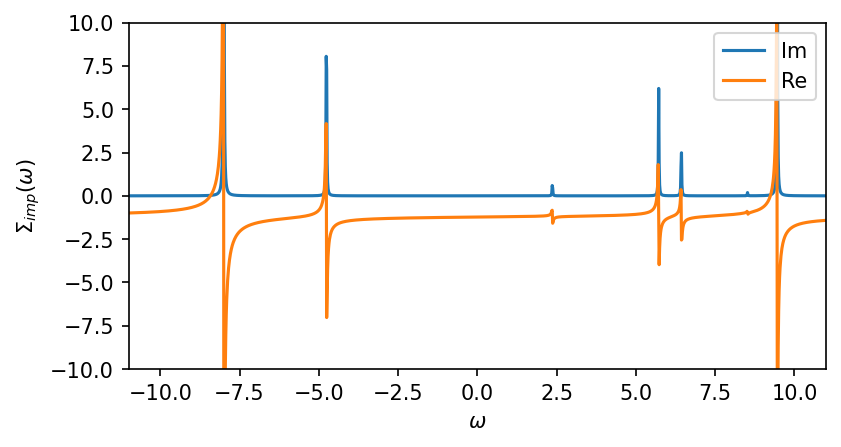
Running the Nevanlinna analytic continuation
[7]:
from triqs_Nevanlinna import Solver
Warning: could not identify MPI environment!
Starting serial run at: 2023-07-19 16:10:02.858691
first we setup the Nevanlinna solver for diagonal Green’s functions (matrix values Green’s functions can be continued using the “CARATHEODORY” kernel. See tutorial XYZ. Now we want to continue both the impurity Green’s function and the self-energy from the Matsubara axis to the real frequency axis:
[8]:
fig, ax = plt.subplots(2,1, figsize=(7,6), dpi=150, squeeze=False, sharex=True)
ax = ax.reshape(-1)
fig.subplots_adjust(hspace=0.03)
ax[0].oplot(G_iw['up'][0,0].real, label='Re')
ax[0].oplot(G_iw['up'][0,0].imag, label='Im')
ax[0].set_ylabel(r'G$_{imp} (i \omega_n)$')
ax[0].set_xlim(0,40)
ax[1].oplot(S_iw['up'][0,0].real-S_iw['up'][0,0].data[-1].real, label='Re - $\Sigma^\infty$')
ax[1].oplot(S_iw['up'][0,0].imag, label='Im')
ax[1].set_ylabel(r'$\Sigma_{imp} (i \omega_n)$')
plt.show()
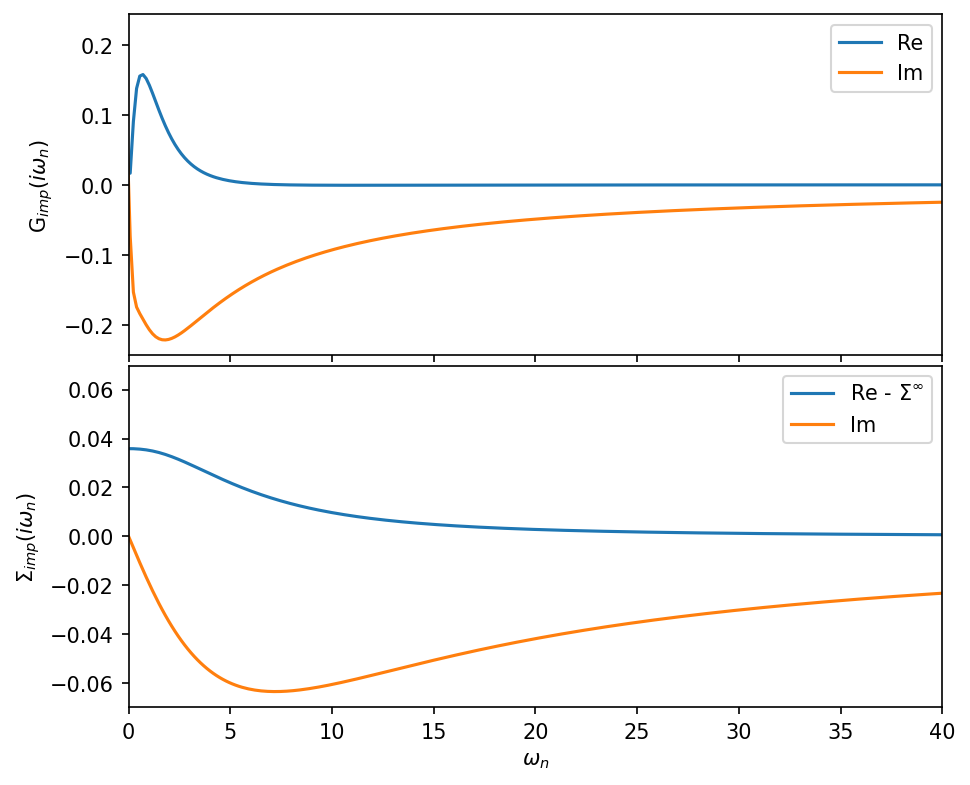
[9]:
# setup Nevanlinna kernel solver
solver = Solver(kernel='NEVANLINNA')
# solve
solver.solve(G_iw['up'])
# evaluate on real frequency mesh
G_w_nvla = solver.evaluate(w_mesh, eta)
This is Nevanlinna analytical continuation. All off-diagonal elements will be ignored.
[10]:
fig, ax = plt.subplots(1,1, figsize=(6,3), dpi=150, squeeze=False)
ax = ax.reshape(-1)
ax[0].oplot(-G_w['up'][0,0].imag, label='ED')
ax[0].oplot(-G_w_nvla[0,0].imag,'--',label='Nevanlinna')
ax[0].set_ylabel(r'Im G$_{imp} (\omega)$')
ax[0].set_ylim(0,2)
ax[0].set_xlim(window)
plt.show()
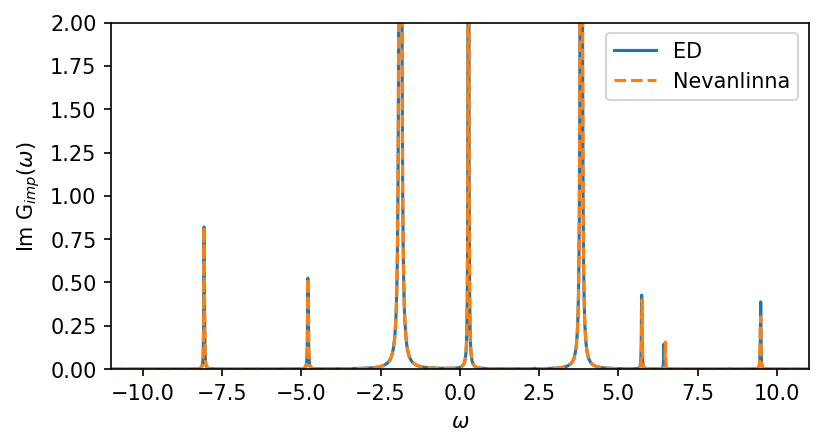
Continuing the self-energy
The self-energy can be continued without any prior treatment in the same as a Green’s function:
[11]:
# setup Nevanlinna kernel solver
solver = Solver(kernel='NEVANLINNA')
# removing the Hartree shift not necessary in Nevanlinna
solver.solve(S_iw['up'])
S_w_nvla = solver.evaluate(w_mesh, eta)
This is Nevanlinna analytical continuation. All off-diagonal elements will be ignored.
Alternative method: remove Hartree shift before analytic continuation.
[12]:
fig, ax = plt.subplots(1,1, figsize=(6,3), dpi=150, squeeze=False)
ax = ax.reshape(-1)
ax[0].oplot(-S_w['up'][0,0].real, label='ED')
ax[0].oplot(-S_w_nvla[0,0].real,'--',label='Nevanlinna')
ax[0].set_ylabel(r'Re $\Sigma_{imp} (\omega)$')
ax[0].set_ylim(-10,10)
ax[0].set_xlim(window)
plt.show()
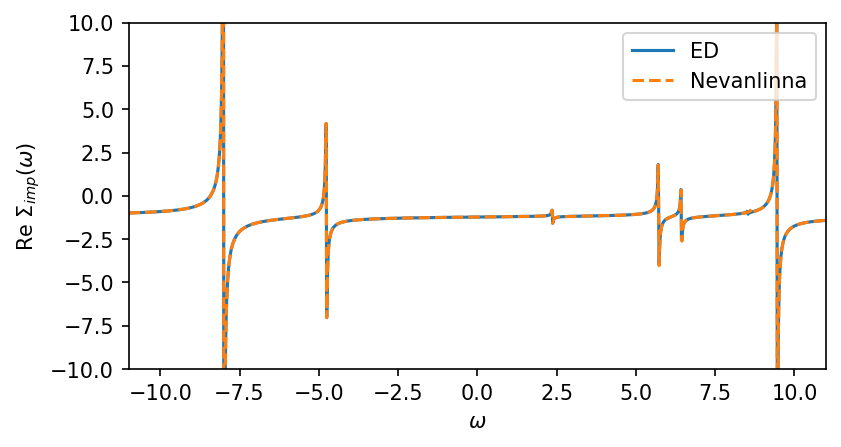
Comparison to Pade & MaxEnt
[13]:
from triqs_maxent import *
run Pade
[14]:
G_w_pade = G0_w['up'].copy()
G_w_pade.set_from_pade(G_iw['up'], n_points=n_iw, freq_offset=eta)
run MaxEnt
[15]:
G_tau = make_gf_from_fourier(G_iw['up'])
G_tau_noisy = G_tau.copy()
noise = 1e-5
G_tau_noisy.data[:,0,0] += np.random.normal(0.0,noise,(len(G_tau.mesh)))
[16]:
tm = TauMaxEnt(cost_function='bryan', probability='normal')
tm.set_G_tau(G_tau_noisy)
tm.set_error(1.e-4)
tm.omega = LinearOmegaMesh(omega_min=window[0], omega_max=window[1], n_points=501)
result = tm.run()
print(('LineFit: ', result.analyzer_results['LineFitAnalyzer']['alpha_index']))
2023-07-19 16:10:28.480252
MaxEnt run
TRIQS application maxent
Copyright(C) 2018 Gernot J. Kraberger
Copyright(C) 2018 Simons Foundation
Authors: Gernot J. Kraberger and Manuel Zingl
This program comes with ABSOLUTELY NO WARRANTY.
This is free software, and you are welcome to redistributeit under certain conditions; see file LICENSE.
Please cite this code and the appropriate original papers (see documentation).
Minimal chi2: 48.296279744358564
scaling alpha by a factor 4801 (number of data points)
alpha[ 0] = 9.60200000e+04, chi2 = 3.88573505e+04, n_iter= 40
alpha[ 1] = 5.05079943e+04, chi2 = 1.98027549e+04, n_iter= 17
alpha[ 2] = 2.65679805e+04, chi2 = 9.96341256e+03, n_iter= 18
alpha[ 3] = 1.39751657e+04, chi2 = 4.89046815e+03, n_iter= 24
alpha[ 4] = 7.35115173e+03, chi2 = 2.40113193e+03, n_iter= 27
alpha[ 5] = 3.86681868e+03, chi2 = 1.24173724e+03, n_iter= 28
alpha[ 6] = 2.03400600e+03, chi2 = 7.13263797e+02, n_iter= 30
alpha[ 7] = 1.06991839e+03, chi2 = 4.51247957e+02, n_iter= 41
alpha[ 8] = 5.62793499e+02, chi2 = 2.95015296e+02, n_iter= 55
alpha[ 9] = 2.96038022e+02, chi2 = 1.95051695e+02, n_iter= 59
alpha[10] = 1.55720545e+02, chi2 = 1.40423030e+02, n_iter= 69
alpha[11] = 8.19113975e+01, chi2 = 1.11683057e+02, n_iter= 84
alpha[12] = 4.30866528e+01, chi2 = 9.68692193e+01, n_iter= 108
alpha[13] = 2.26642409e+01, chi2 = 8.93634804e+01, n_iter= 132
alpha[14] = 1.19217387e+01, chi2 = 8.55377018e+01, n_iter= 182
alpha[15] = 6.27101762e+00, chi2 = 8.33634810e+01, n_iter= 259
alpha[16] = 3.29865155e+00, chi2 = 8.19865396e+01, n_iter= 356
alpha[17] = 1.73514137e+00, chi2 = 8.12078468e+01, n_iter= 473
alpha[18] = 9.12711000e-01, chi2 = 8.07965385e+01, n_iter= 603
alpha[19] = 4.80100000e-01, chi2 = 8.05776533e+01, n_iter= 750
MaxEnt loop finished in 0:01:01.850617
('LineFit: ', 10)
plot results of continuation
let’s plot all results in comparison. The Nevanlinna, Pade, and MaxEnt results are each shifted by a small amount on the x-axis to visualize better the agreement in the first plot:
[17]:
fig, ax = plt.subplots(2,1, figsize=(9,6), dpi=150, squeeze=False, sharex=True)
ax = ax.reshape(-1)
fig.subplots_adjust(hspace=0.03)
w_mesh_arr = np.linspace(w_mesh.w_min, w_mesh.w_max, len(w_mesh))
# prepare Maxent data on finder mesh
G_w_maxent = np.interp(w_mesh_arr, np.array(result.omega), result.analyzer_results['BryanAnalyzer']['A_out'])
# we plot each result slighlty shifted on the x-axis for better visibility
# 1 Im G
ax[0].plot(w_mesh_arr, -G_w['up'][0,0].data.imag, color='C6', label='ED')
ax[0].plot(w_mesh_arr+0.3, -G_w_nvla[0,0].data.imag,label='Nevanlinna')
ax[0].plot(w_mesh_arr+0.6, -G_w_pade[0,0].data.imag,label='Pade')
ax[0].plot(w_mesh_arr+0.9, G_w_maxent, label='MaxEnt')
# 2 abs difference of G
ax[1].semilogy(w_mesh_arr, np.abs(G_w['up'][0,0].data.imag - G_w_nvla[0,0].data.imag), label='Nevanlinna')
ax[1].semilogy(w_mesh_arr, np.abs(G_w['up'][0,0].data.imag - G_w_pade[0,0].data.imag), label='Pade')
ax[1].semilogy(w_mesh_arr, np.abs(G_w['up'][0,0].data.imag - G_w_maxent), label='MaxEnt')
# decorations
ax[0].set_ylabel(r'Im G$_{imp} (\omega)$')
ax[0].set_ylim(0,2)
ax[0].legend()
ax[1].set_ylabel(r' |Im $ G_{imp} (\omega)$ - G$_{imp}^{ED} (\omega) |$')
ax[1].set_xlim(window)
ax[1].legend()
plt.show()
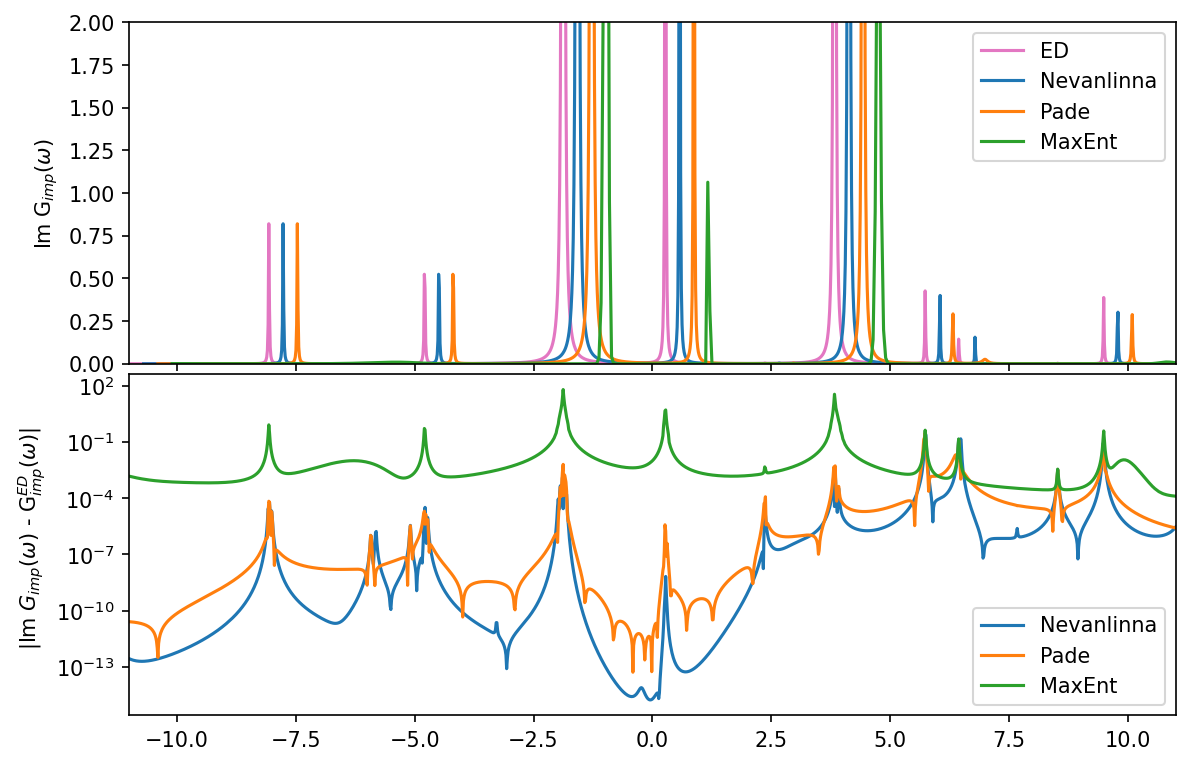
\(\Sigma\) comparison to Pade
Before we compare all results we also continue the self-energy via Pade approximants:
[18]:
S_w_pade = G0_w['up'].copy()
S_w_pade.set_from_pade(S_iw['up'], n_points=n_iw, freq_offset=eta)
[19]:
fig, ax = plt.subplots(3,1, figsize=(9,9), dpi=150, squeeze=False, sharex=True)
ax = ax.reshape(-1)
fig.subplots_adjust(hspace=0.03)
w_mesh_arr = np.linspace(w_mesh.w_min, w_mesh.w_max, len(w_mesh))
# we plot each result slighlty shifted on the x-axis for better visibility
# 1 Re Sigma
ax[0].plot(w_mesh_arr, S_w['up'][0,0].data.real - S_w['up'][0,0](0.0).real, color='C6', label='ED')
ax[0].plot(w_mesh_arr+0.3, S_w_pade[0,0].data.real - S_w_pade[0,0](0.0).real,label='Pade')
ax[0].plot(w_mesh_arr+0.6, S_w_nvla[0,0].data.real - S_w_nvla[0,0](0.0).real,label='Nevanlinna')
# 2 Im Sigma
ax[1].plot(w_mesh_arr, -S_w['up'][0,0].data.imag, color='C6', label='ED')
ax[1].plot(w_mesh_arr+0.3, -S_w_pade[0,0].data.imag,label='Pade')
ax[1].plot(w_mesh_arr+0.6, -S_w_nvla[0,0].data.imag,label='Nevanlinna')
# 3 abs difference
ax[2].semilogy(w_mesh_arr, np.abs(S_w['up'][0,0].data.imag - S_w_pade[0,0].data.imag), label='Pade')
ax[2].semilogy(w_mesh_arr, np.abs(S_w['up'][0,0].data.imag - S_w_nvla[0,0].data.imag), label='Nevanlinna')
# decorations
ax[0].set_ylabel(r'Re $\Sigma_{imp} (\omega)$')
ax[0].legend()
ax[1].set_ylabel(r'Im $\Sigma_{imp} (\omega)$')
ax[1].set_xlim(window)
ax[2].set_ylabel(r' |Im $ \Sigma_{imp} (\omega)$ - $\Sigma_{imp}^{ED} (\omega) |$')
ax[2].set_xlim(window)
ax[2].set_ylim(1e-15,1e-0)
ax[2].legend()
plt.show()
